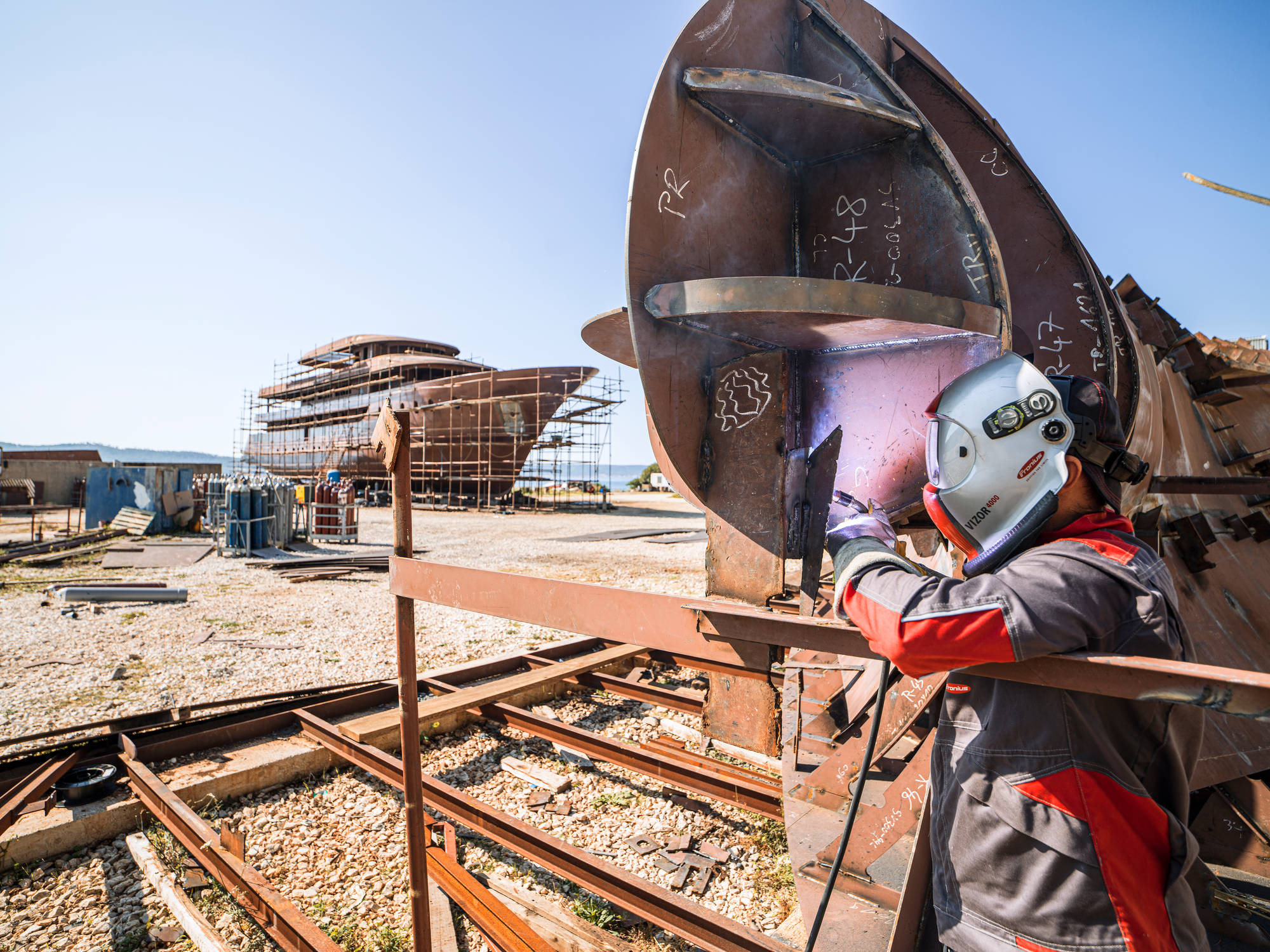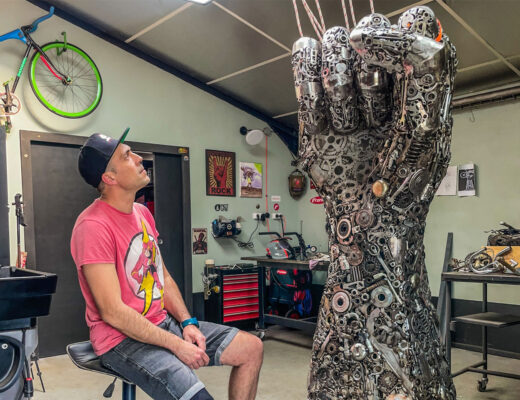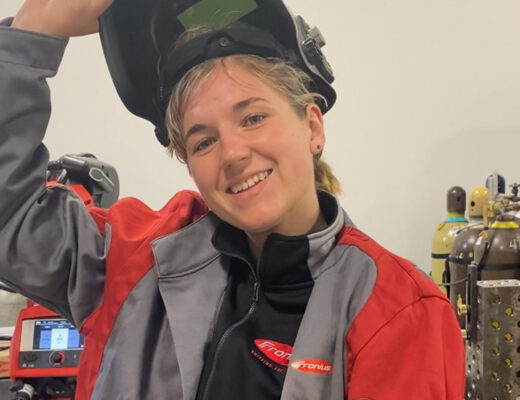Welding in shipbuilding – a Herculean task. The Gulet shipyard in Croatia primarily builds cruise ships in the form of large yachts, so is well placed to report extensively on the extreme welding challenges faced in the industry: limited space requires great skill and reliable selection of the suitable welding position. Welding while lying down or kneeling are par for the course here.
The rugged, rocky Adriatic coast of Croatia spans 6000 kilometers. Set against the backdrop of turquoise waters and the diverse islands, it is a paradise for fans of sailing or other water-related activities. Besides countless water sports, cruises are also gaining in popularity. The ports of call include the many historic coastal towns, such as Trogir with its enchanting historical center. It also happens to be the port that the Gulet shipyard calls home. Since its foundation in 2015, the yard, which currently employs 16 staff, has already built eight ships: “Roughly six months need to be scheduled for a ship. But, as all of our welding work is performed outdoors, the actual building time depends heavily on the weather conditions”, explains Mirko Purić, Proprietor of Gulet. “That’s why we need tough and high-quality welding systems, which can withstand the, in some cases, extreme conditions and offer reliable operation.”
Shipbuilding and the Specific Challenges for Gulet
In general, the shipyard’s infrastructure means that everything is welded by hand. Simple shipbuilding steel is mostly used, so that the four qualified professional welders primarily use the MAG welding process. As well as the standard requirements in shipbuilding, the shipyard also has to deal with the sometimes-extreme summer temperatures of up to 50°C, which also increase even further due to the absence of roofs that provide any shade. Another challenge is the confined space inside the ship; in the bow, heights can even be below 40 centimeters. Besides standing, welding while kneeling or lying is often a necessity – it’s clear that welding requires the full use of the body. “Vertical, horizontal, and angled welding are naturally basic requirements, which is what makes it so difficult to find top-quality welders”, explains shipyard owner Puric, referring to the problematic conditions.
Puric is fortunate, however, in that all of his employees are absolute professionals. However, in order to focus fully on the, in some cases, huge welding challenges, welders place great importance on user-friendly devices. In Puric’s eyes, another benefit of easy-to-use welding systems is that initial training of new employees can be completed in no time at all – a brief induction is all that is needed to understand the welding systems.
The fact that the Gulet shipyard exclusively builds its ships outdoors on the pier has the benefit that the completed passenger liners can be launched directly from the shipyard, without any additional transportation required. However, this means that they do not have access to any roofed halls, so the weather conditions can add additional difficulty to their work. Wind and moisture are particular challenges, as they can significant influence the welding results. In some cases, working outdoors also requires welding with rod electrodes, as the protective gas shield is not affected.
In addition to the weather conditions, the large amount of tacking work, distributed across the entire ship, also necessitates the use of rod electrodes for welding. This means that mobility is also an issue: compact and light welding systems, in some cases weighing less than 5 kilograms, which can instantly be transported to the remotest of places, are essential here. At the same time, the welding challenges need to be mastered with a high level of professionalism and the greatest possible arc stability.
Rigorous Inspection of Steel Plates and Weld Seams
Gulet primarily builds cruise ships with a maximum length of 120 meters, using shipbuilding steel classified by DNV GL (Germanischer Lloyd). “Plates without a test certificate from Lloyd first need to be transported to Split for hardness and bending testing. It’s the only way to ensure that the steel plates that we machine do not have any quality defects,” continues Purić. The classification society Germanischer Lloyd also provides for the use of DNV GL-approved rutile flux core wires – in the case of Gulet, they have a diameter of 1.2 mm.
The use of flux core wire is actually somewhat of a relic from the time of analog power sources: the powder filling makes the welding process even less dependent on the surface, as the slag forms around the weld seam, which significantly reduces spatter. This is hugely important during subsequent acceptance, as both the strength and the aesthetics of a seam play a critical role. From a purely technical perspective, the use of flux core wires should no longer be necessary in times of digital power sources. Modern welding systems, such as those used at the Gulet shipyard, provide high process stability, and the use of flux core wires can be considered an additional bonus for the look of the weld seam. Secondly, it also makes a necessary contribution to productivity in welding vertical-up seams.
Characteristics and Requirements in Designing Welding Systems in Shipbuilding
MAG flux-cored wire welding in the age of digital power sources requires one thing above all else: the necessary characteristics for shipbuilding, which a modern welding system should have. The flux core wire characteristic is a prerequisite for the requirements for coated shipbuilding steel as well as for the use of rutile flux core wires.
However, as the tolerances of the plates used in shipbuilding are considerably greater than those in automotive manufacturing, for example, good gap-bridging ability is another key requirement. This is an area in which specially developed characteristics can help, particularly for the root pass of pipe joints.
Besides the process engineering innovations, shipbuilders specifically need welding systems with an extremely tough design. Absolute durability is a must – this is part of the nature of shipbuilding with heavy steel, where the equipment is not exactly kept in cotton wool!
Inspection with Chalk and Petroleum
Gulet builds ships in individual sections. After individual construction segments are joined, this join is inspected by an independent examiner – at least ten times during the construction process, as the ships are comprised of at least ten segments. For example, when the keel, a ship’s most important horizontal bracing, is joined with the outer hull, the examiner rigorously inspects all the materials used. The weld seams on the shell plating of the outer hull are usually coated with chalk, and with petroleum on the inside. If the petroleum penetrates to the outside, the discoloration is clearly visible in the chalk on the other side of the hull, which indicates a hole in the weld seam. This is followed by extensive repairs to the weld seam: milling, grinding, and rewelding.
Yet another area in which welding systems with digital process control can display their benefits. The flexible range of functions provides valuable options: for instance, the welding process can be optimized with arc length correction and numerous other options to minimize laborious reworking activities.
X-rays of the Cross Joints
In line with the requirements imposed by Germanischer Lloyd, the examiner takes X-rays of about 30 percent of the cross joints on a ship. Small black dots in the picture indicate that the weld metal may contain slag residues. As the seam is likely to be porous, the welding once again needs to start from scratch: from the root, the slag is meticulously removed layer by layer down to the intermediate and filling runs.
The shipbuilder is subject to strict checks. X-rays are taken of about 30 percent of the cross joints on a ship
Gulet and Future Prospects
The complexity of the work and checks involved makes one thing absolutely clear: Gulet is intent on delivering quality and is capable of doing so. Ultimately, this is the reason why the Croatian shipyard integrated the latest process engineering for welding equipment into its production area. It seems as if cruise ships are only the start of the shipbuilder’s high-quality product portfolio: in future, Gulet also wants to build ships for deep-sea fishing – the first trawler is already under construction.
Want to Know More?
The Fronius product portfolio includes devices that are ideal for use in shipbuilding. The Gulet shipyard’s requirements in MAG welding are largely covered by the TransSteel 5000. For smaller tacking activities with rod electrodes, the shipbuilders turn to the Transpocket 150. At under five kilograms, the lightweight device can be transported anywhere in an instant.
 Perfect Welding Blog
Perfect Welding Blog




No Comments